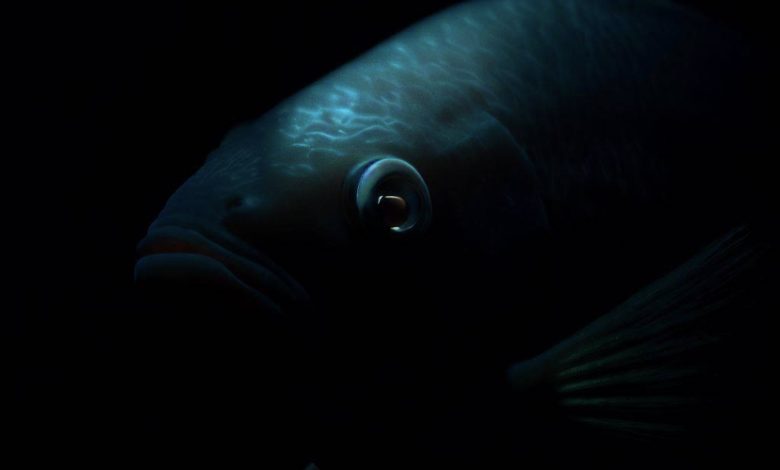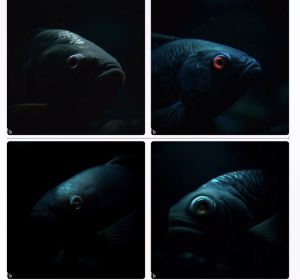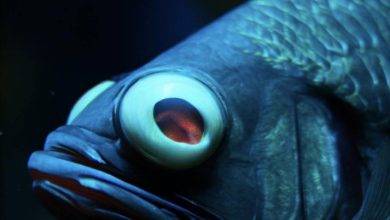Can Fish See in the Dark?

Ever wondered Can Fish See in the Dark? Well, get ready to dive into the incredible world of fish vision! Fish are not just swimmers; they’re expert navigators who rely on their senses to explore and survive in their watery habitats. In this article, we’ll take a relaxed and captivating journey through the underwater realm as we uncover whether fish can see in the dark. So, let’s plunge into the depths and discover the secrets of fish vision!
Can Fish See in the Dark?

Yes, fish have developed the ability to see in low-light conditions, enabling them to navigate and hunt effectively in dark environments. They possess specialized cells called rod cells in their eyes, which are highly sensitive to light. However, their vision in complete darkness is limited, so they rely on other senses like their lateral line system and electroreception to navigate in such conditions.
What types of fish can see in the dark?
Now, you may be wondering which fish species are the true champions of low-light vision. While no fish can truly see in complete darkness, there are some remarkable contenders that have adapted to thrive in dimly lit environments.
Deep–sea dwellers, such as lanternfish, dragonfish, and hatchet fish, are among the stars of the dark depths. These incredible creatures have evolved specialized adaptations that allow them to perceive and respond to the faint bioluminescent light emitted by other organisms in their pitch-black habitat. It’s like having their very own underwater disco party!
How do fish perceive their environment?
Just like us, fish rely on their senses to make sense of the world around them. While humans lean heavily on vision, fish have an entire sensory arsenal at their fins! Of course, vision plays a vital role in their daily lives, helping them locate food, evade predators, and find their way through the aquatic maze.
Fish have evolved incredible adaptations that allow them to excel in their underwater world. Alongside vision, they possess acute hearing and a remarkable sense of smell. It’s a fascinating blend of sensory superpowers that helps fish interact with their environment in extraordinary ways.
The Role of Vision in fish behavior
Picture this: a school of colorful fish darting through vibrant coral reefs. Vision is the key to their synchronized dance! Fish rely on their eyes to navigate, communicate, and interact with their surroundings. Whether it’s finding a mate, spotting prey, or avoiding danger, their visual abilities shape their behavior in captivating ways.
Beyond the beauty, fish vision is all about survival. Their eyes are finely tuned to detect subtle movements, contrasting shapes, and even camouflage techniques used by predators. It’s an intricate dance between eyes and environment that keeps fish one step ahead in the underwater game of life.
Adaptations of fish for low-light conditions
Imagine being a fish swimming in the twilight zone where the sunlight struggles to reach. How do they cope? Well, Mother Nature has equipped these amazing creatures with an array of adaptations that make low-light living a breeze.
One remarkable adaptation is the presence of a reflective layer called the tapetum lucidum in some fish eyes. This layer enhances their ability to gather and utilize available light, giving them an advantage in dark environments. Combined with other features like large pupils and a well-developed retina, fish are true masters of adapting to their unique habitats.
The importance of Light in fish habitats
Light is not just a source of illumination for fish; it holds profound significance in their habitats. It influences various biological processes and behaviors, shaping the lives of these aquatic inhabitants in ways we’re only beginning to understand.
Light plays a crucial role in fish feeding patterns, breeding behavior, and even their daily activity cycles. It acts as a cue for migration, helps with predator detection, and aids in camouflage. So, the presence or absence of light can be a game-changer for fish and their interactions within their watery ecosystems.
Comparing fish vision to human vision
Let’s take a moment to compare fish vision to our own. Fish eyes have evolved to excel in an underwater environment, while our eyes are fine-tuned for life on land. Each has its unique strengths and limitations, making for a fascinating comparison.
Fish eyes often have a broader field of view, allowing them to see what’s happening around them without turning their heads. They can also detect subtle movements and colors that may elude our human eyes. However, when it comes to detailed vision and perceiving fine details, our eyes take the lead. It’s a reminder of the incredible diversity of vision systems across the animal kingdom.
Exploring the Anatomy of fish eyes
To truly appreciate the wonders of fish vision, let’s dive into the anatomy of their eyes. Fish eyes are marvels of nature, optimized for underwater life. While they may not have eyelashes or fancy eyeshadow, their structures are finely tuned for their aquatic adventures.
From the cornea and lens that focus incoming light, to the retina and optic nerve that process visual information, every component has a crucial role to play. Some fish even have a unique structure called the fovea, which helps them focus on specific objects or prey. It’s an intricate system that has evolved over millennia, allowing fish to navigate their watery world with finesse.
Can goldfish see in the dark?
Goldfish are known for their beautiful colors and graceful movements, but can they see in the dark? While goldfish have good vision overall, their ability to see in low-light conditions is limited. They rely heavily on their sense of smell and lateral line system to navigate when visibility is reduced.
However, in extremely dark environments, their vision becomes less effective. It’s important to provide adequate lighting in goldfish tanks to ensure they can see and explore their surroundings comfortably.
Subheading 2: Can betta fish see in the dark?
Betta fish, also known as Siamese fighting fish, possess unique vision adaptations. They have excellent eyesight and can see in various light conditions, including dimly lit environments.
While they are not true night vision experts, betta fish can navigate and locate food in low-light conditions better than many other fish species. Their keen eyesight allows them to detect movements and perceive their environment with remarkable clarity, even in darker settings.
Can tropical fish see in the dark?
Tropical fish come in a dazzling array of colors and patterns, making them a popular choice for aquarium enthusiasts. When it comes to their vision in the dark, tropical fish exhibit a range of abilities depending on the species. Some tropical fish have adapted to low-light conditions in their natural habitats, allowing them to see reasonably well in dimly lit environments.
However, it’s important to note that their visual acuity may still be reduced compared to brightly lit surroundings. Providing appropriate lighting in tropical fish tanks ensures they can exhibit their vibrant colors and navigate their environment effectively.
Conclusion
From the depths of the ocean to the shimmering surfaces of freshwater lakes, fish possess incredible visual adaptations that allow them to thrive in a wide range of environments.
While they may not have true night vision, their remarkable abilities to see in low-light conditions and navigate their watery habitats are a testament to their adaptability and resilience.
So, the next time you encounter a fish, take a moment to appreciate the wonders of their visual world beneath the waves. It’s a captivating realm where light and darkness intertwine, and fish reign supreme as the masters of aquatic perception.





